School Bullying: Types, Impacts, and Prevention
VerifiedAdded on 2022/12/26
|7
|1857
|67
AI Summary
This article discusses the issue of school bullying, including its various types and the harmful impacts it has on students. It highlights the importance of awareness and prevention strategies to address this problem. The article also emphasizes the role of parents and schools in tackling bullying and promoting a safe and supportive environment for students.
Contribute Materials
Your contribution can guide someone’s learning journey. Share your
documents today.
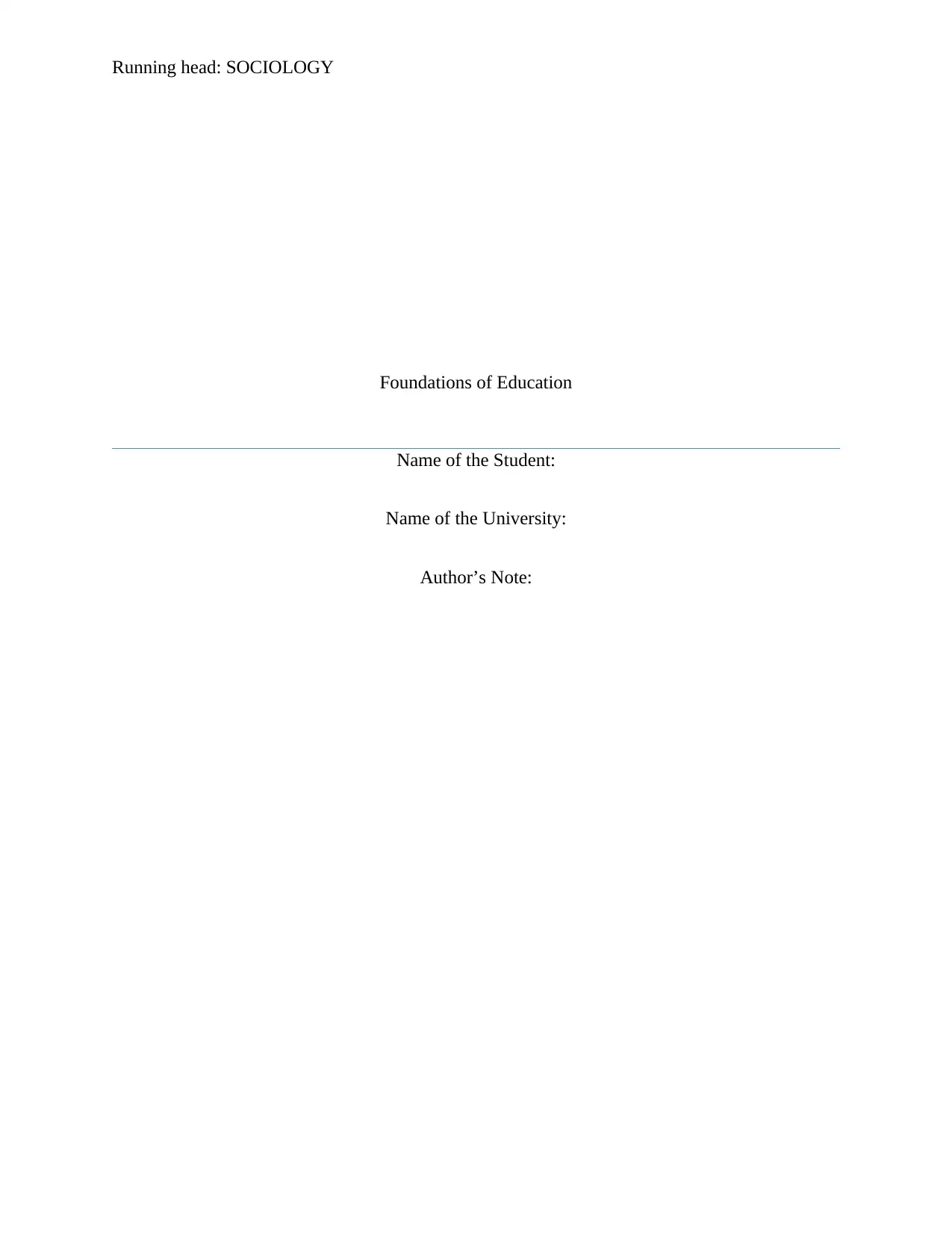
Running head: SOCIOLOGY
Foundations of Education
Name of the Student:
Name of the University:
Author’s Note:
Foundations of Education
Name of the Student:
Name of the University:
Author’s Note:
Secure Best Marks with AI Grader
Need help grading? Try our AI Grader for instant feedback on your assignments.
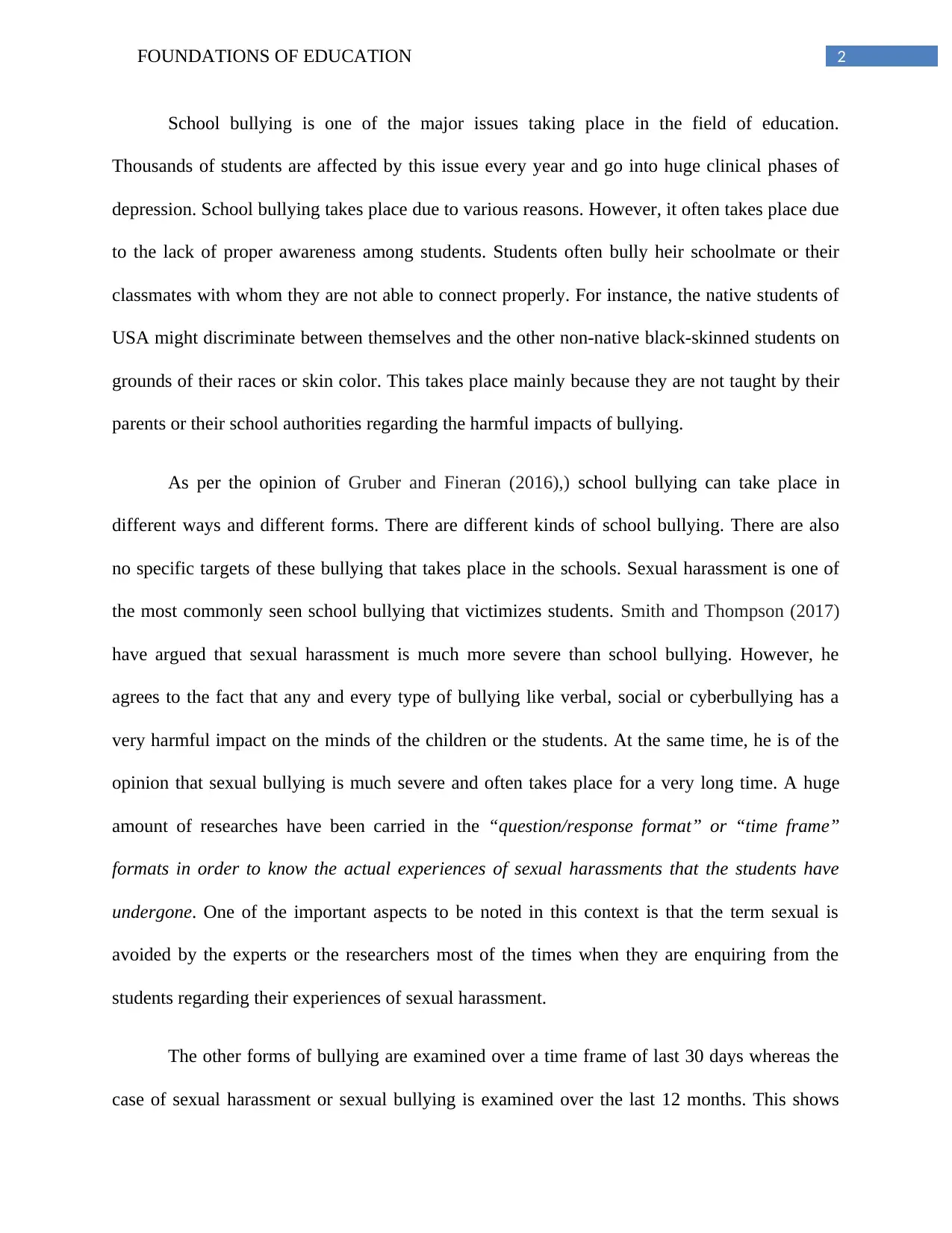
2FOUNDATIONS OF EDUCATION
School bullying is one of the major issues taking place in the field of education.
Thousands of students are affected by this issue every year and go into huge clinical phases of
depression. School bullying takes place due to various reasons. However, it often takes place due
to the lack of proper awareness among students. Students often bully heir schoolmate or their
classmates with whom they are not able to connect properly. For instance, the native students of
USA might discriminate between themselves and the other non-native black-skinned students on
grounds of their races or skin color. This takes place mainly because they are not taught by their
parents or their school authorities regarding the harmful impacts of bullying.
As per the opinion of Gruber and Fineran (2016),) school bullying can take place in
different ways and different forms. There are different kinds of school bullying. There are also
no specific targets of these bullying that takes place in the schools. Sexual harassment is one of
the most commonly seen school bullying that victimizes students. Smith and Thompson (2017)
have argued that sexual harassment is much more severe than school bullying. However, he
agrees to the fact that any and every type of bullying like verbal, social or cyberbullying has a
very harmful impact on the minds of the children or the students. At the same time, he is of the
opinion that sexual bullying is much severe and often takes place for a very long time. A huge
amount of researches have been carried in the “question/response format” or “time frame”
formats in order to know the actual experiences of sexual harassments that the students have
undergone. One of the important aspects to be noted in this context is that the term sexual is
avoided by the experts or the researchers most of the times when they are enquiring from the
students regarding their experiences of sexual harassment.
The other forms of bullying are examined over a time frame of last 30 days whereas the
case of sexual harassment or sexual bullying is examined over the last 12 months. This shows
School bullying is one of the major issues taking place in the field of education.
Thousands of students are affected by this issue every year and go into huge clinical phases of
depression. School bullying takes place due to various reasons. However, it often takes place due
to the lack of proper awareness among students. Students often bully heir schoolmate or their
classmates with whom they are not able to connect properly. For instance, the native students of
USA might discriminate between themselves and the other non-native black-skinned students on
grounds of their races or skin color. This takes place mainly because they are not taught by their
parents or their school authorities regarding the harmful impacts of bullying.
As per the opinion of Gruber and Fineran (2016),) school bullying can take place in
different ways and different forms. There are different kinds of school bullying. There are also
no specific targets of these bullying that takes place in the schools. Sexual harassment is one of
the most commonly seen school bullying that victimizes students. Smith and Thompson (2017)
have argued that sexual harassment is much more severe than school bullying. However, he
agrees to the fact that any and every type of bullying like verbal, social or cyberbullying has a
very harmful impact on the minds of the children or the students. At the same time, he is of the
opinion that sexual bullying is much severe and often takes place for a very long time. A huge
amount of researches have been carried in the “question/response format” or “time frame”
formats in order to know the actual experiences of sexual harassments that the students have
undergone. One of the important aspects to be noted in this context is that the term sexual is
avoided by the experts or the researchers most of the times when they are enquiring from the
students regarding their experiences of sexual harassment.
The other forms of bullying are examined over a time frame of last 30 days whereas the
case of sexual harassment or sexual bullying is examined over the last 12 months. This shows
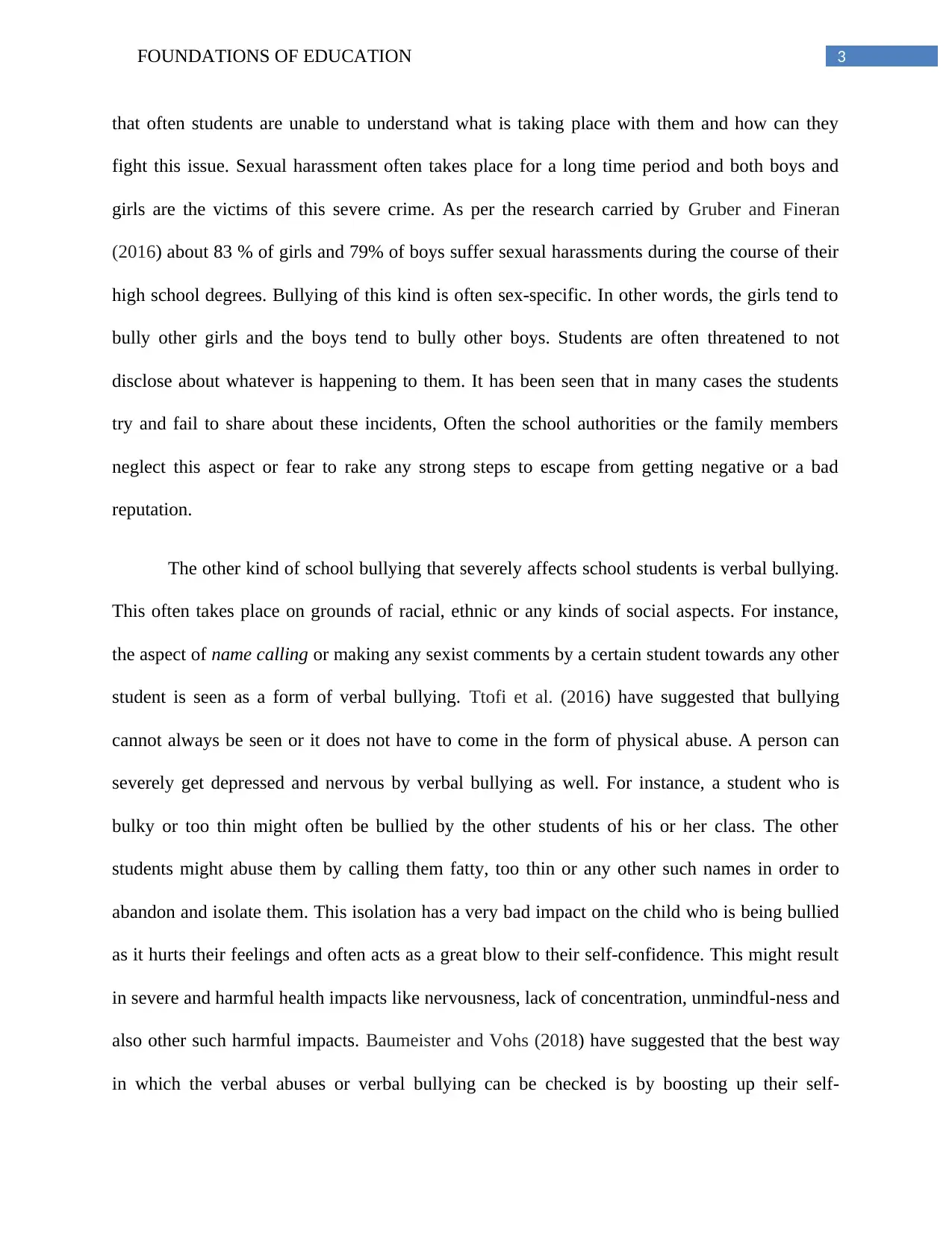
3FOUNDATIONS OF EDUCATION
that often students are unable to understand what is taking place with them and how can they
fight this issue. Sexual harassment often takes place for a long time period and both boys and
girls are the victims of this severe crime. As per the research carried by Gruber and Fineran
(2016) about 83 % of girls and 79% of boys suffer sexual harassments during the course of their
high school degrees. Bullying of this kind is often sex-specific. In other words, the girls tend to
bully other girls and the boys tend to bully other boys. Students are often threatened to not
disclose about whatever is happening to them. It has been seen that in many cases the students
try and fail to share about these incidents, Often the school authorities or the family members
neglect this aspect or fear to rake any strong steps to escape from getting negative or a bad
reputation.
The other kind of school bullying that severely affects school students is verbal bullying.
This often takes place on grounds of racial, ethnic or any kinds of social aspects. For instance,
the aspect of name calling or making any sexist comments by a certain student towards any other
student is seen as a form of verbal bullying. Ttofi et al. (2016) have suggested that bullying
cannot always be seen or it does not have to come in the form of physical abuse. A person can
severely get depressed and nervous by verbal bullying as well. For instance, a student who is
bulky or too thin might often be bullied by the other students of his or her class. The other
students might abuse them by calling them fatty, too thin or any other such names in order to
abandon and isolate them. This isolation has a very bad impact on the child who is being bullied
as it hurts their feelings and often acts as a great blow to their self-confidence. This might result
in severe and harmful health impacts like nervousness, lack of concentration, unmindful-ness and
also other such harmful impacts. Baumeister and Vohs (2018) have suggested that the best way
in which the verbal abuses or verbal bullying can be checked is by boosting up their self-
that often students are unable to understand what is taking place with them and how can they
fight this issue. Sexual harassment often takes place for a long time period and both boys and
girls are the victims of this severe crime. As per the research carried by Gruber and Fineran
(2016) about 83 % of girls and 79% of boys suffer sexual harassments during the course of their
high school degrees. Bullying of this kind is often sex-specific. In other words, the girls tend to
bully other girls and the boys tend to bully other boys. Students are often threatened to not
disclose about whatever is happening to them. It has been seen that in many cases the students
try and fail to share about these incidents, Often the school authorities or the family members
neglect this aspect or fear to rake any strong steps to escape from getting negative or a bad
reputation.
The other kind of school bullying that severely affects school students is verbal bullying.
This often takes place on grounds of racial, ethnic or any kinds of social aspects. For instance,
the aspect of name calling or making any sexist comments by a certain student towards any other
student is seen as a form of verbal bullying. Ttofi et al. (2016) have suggested that bullying
cannot always be seen or it does not have to come in the form of physical abuse. A person can
severely get depressed and nervous by verbal bullying as well. For instance, a student who is
bulky or too thin might often be bullied by the other students of his or her class. The other
students might abuse them by calling them fatty, too thin or any other such names in order to
abandon and isolate them. This isolation has a very bad impact on the child who is being bullied
as it hurts their feelings and often acts as a great blow to their self-confidence. This might result
in severe and harmful health impacts like nervousness, lack of concentration, unmindful-ness and
also other such harmful impacts. Baumeister and Vohs (2018) have suggested that the best way
in which the verbal abuses or verbal bullying can be checked is by boosting up their self-
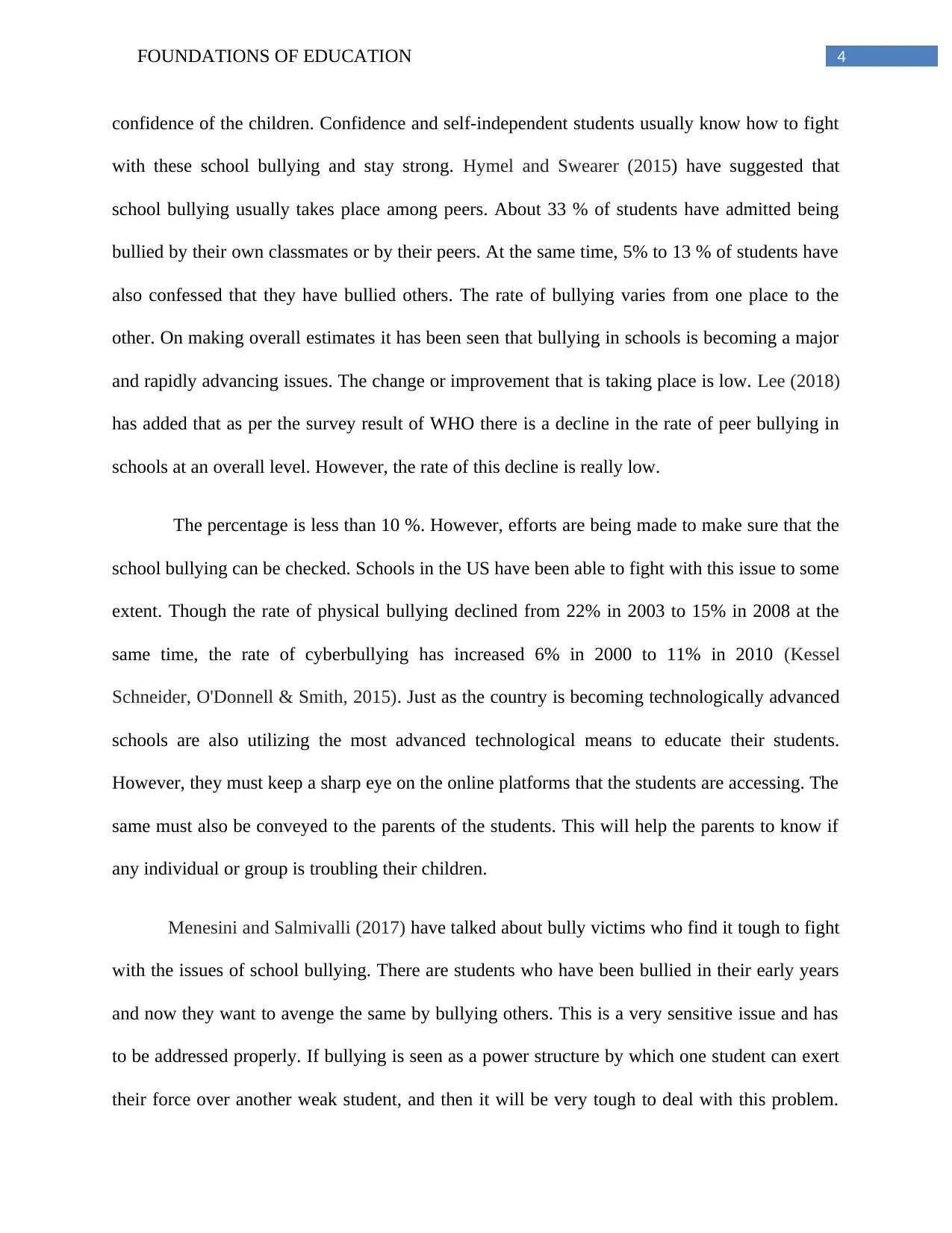
4FOUNDATIONS OF EDUCATION
confidence of the children. Confidence and self-independent students usually know how to fight
with these school bullying and stay strong. Hymel and Swearer (2015) have suggested that
school bullying usually takes place among peers. About 33 % of students have admitted being
bullied by their own classmates or by their peers. At the same time, 5% to 13 % of students have
also confessed that they have bullied others. The rate of bullying varies from one place to the
other. On making overall estimates it has been seen that bullying in schools is becoming a major
and rapidly advancing issues. The change or improvement that is taking place is low. Lee (2018)
has added that as per the survey result of WHO there is a decline in the rate of peer bullying in
schools at an overall level. However, the rate of this decline is really low.
The percentage is less than 10 %. However, efforts are being made to make sure that the
school bullying can be checked. Schools in the US have been able to fight with this issue to some
extent. Though the rate of physical bullying declined from 22% in 2003 to 15% in 2008 at the
same time, the rate of cyberbullying has increased 6% in 2000 to 11% in 2010 (Kessel
Schneider, O'Donnell & Smith, 2015). Just as the country is becoming technologically advanced
schools are also utilizing the most advanced technological means to educate their students.
However, they must keep a sharp eye on the online platforms that the students are accessing. The
same must also be conveyed to the parents of the students. This will help the parents to know if
any individual or group is troubling their children.
Menesini and Salmivalli (2017) have talked about bully victims who find it tough to fight
with the issues of school bullying. There are students who have been bullied in their early years
and now they want to avenge the same by bullying others. This is a very sensitive issue and has
to be addressed properly. If bullying is seen as a power structure by which one student can exert
their force over another weak student, and then it will be very tough to deal with this problem.
confidence of the children. Confidence and self-independent students usually know how to fight
with these school bullying and stay strong. Hymel and Swearer (2015) have suggested that
school bullying usually takes place among peers. About 33 % of students have admitted being
bullied by their own classmates or by their peers. At the same time, 5% to 13 % of students have
also confessed that they have bullied others. The rate of bullying varies from one place to the
other. On making overall estimates it has been seen that bullying in schools is becoming a major
and rapidly advancing issues. The change or improvement that is taking place is low. Lee (2018)
has added that as per the survey result of WHO there is a decline in the rate of peer bullying in
schools at an overall level. However, the rate of this decline is really low.
The percentage is less than 10 %. However, efforts are being made to make sure that the
school bullying can be checked. Schools in the US have been able to fight with this issue to some
extent. Though the rate of physical bullying declined from 22% in 2003 to 15% in 2008 at the
same time, the rate of cyberbullying has increased 6% in 2000 to 11% in 2010 (Kessel
Schneider, O'Donnell & Smith, 2015). Just as the country is becoming technologically advanced
schools are also utilizing the most advanced technological means to educate their students.
However, they must keep a sharp eye on the online platforms that the students are accessing. The
same must also be conveyed to the parents of the students. This will help the parents to know if
any individual or group is troubling their children.
Menesini and Salmivalli (2017) have talked about bully victims who find it tough to fight
with the issues of school bullying. There are students who have been bullied in their early years
and now they want to avenge the same by bullying others. This is a very sensitive issue and has
to be addressed properly. If bullying is seen as a power structure by which one student can exert
their force over another weak student, and then it will be very tough to deal with this problem.
Secure Best Marks with AI Grader
Need help grading? Try our AI Grader for instant feedback on your assignments.
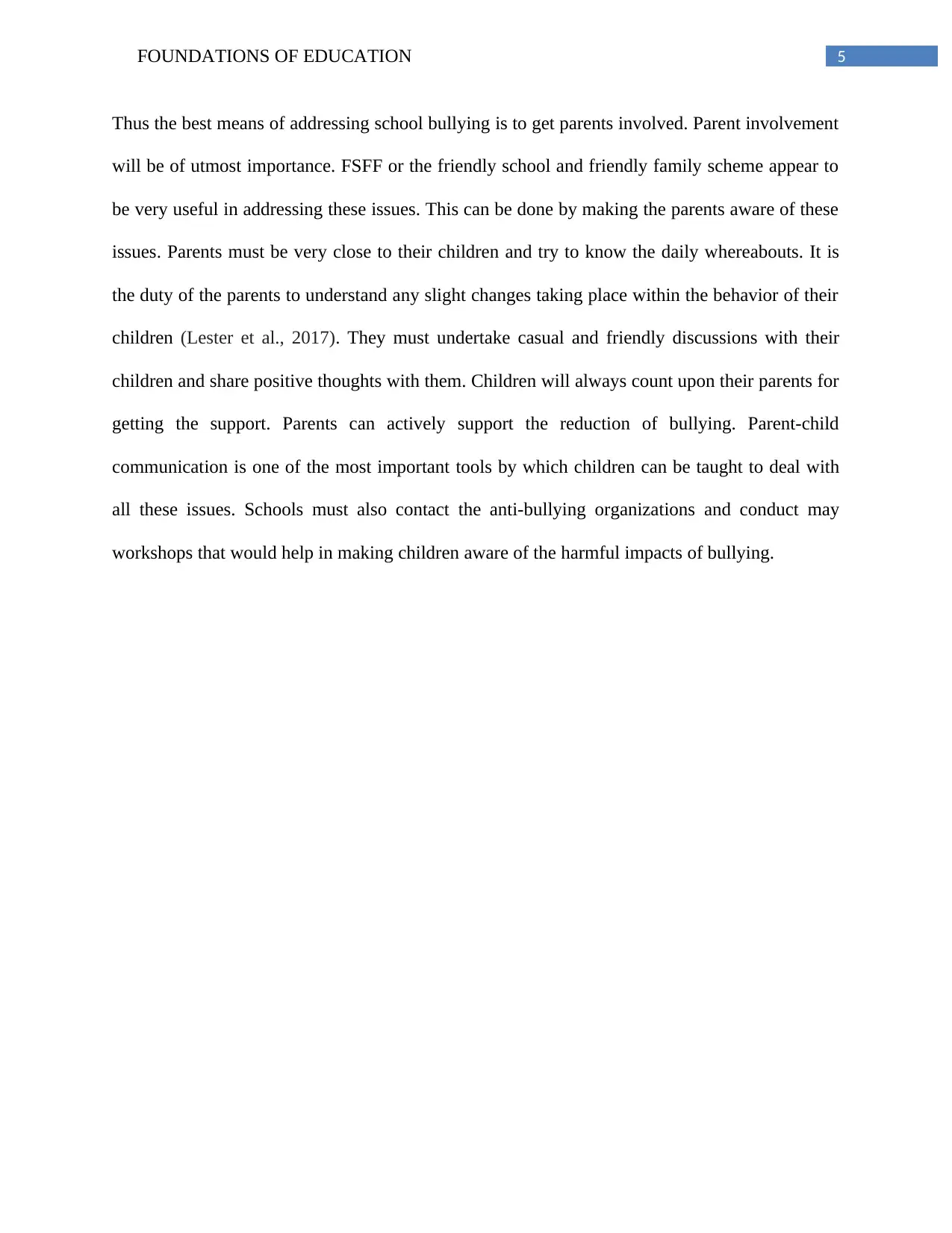
5FOUNDATIONS OF EDUCATION
Thus the best means of addressing school bullying is to get parents involved. Parent involvement
will be of utmost importance. FSFF or the friendly school and friendly family scheme appear to
be very useful in addressing these issues. This can be done by making the parents aware of these
issues. Parents must be very close to their children and try to know the daily whereabouts. It is
the duty of the parents to understand any slight changes taking place within the behavior of their
children (Lester et al., 2017). They must undertake casual and friendly discussions with their
children and share positive thoughts with them. Children will always count upon their parents for
getting the support. Parents can actively support the reduction of bullying. Parent-child
communication is one of the most important tools by which children can be taught to deal with
all these issues. Schools must also contact the anti-bullying organizations and conduct may
workshops that would help in making children aware of the harmful impacts of bullying.
Thus the best means of addressing school bullying is to get parents involved. Parent involvement
will be of utmost importance. FSFF or the friendly school and friendly family scheme appear to
be very useful in addressing these issues. This can be done by making the parents aware of these
issues. Parents must be very close to their children and try to know the daily whereabouts. It is
the duty of the parents to understand any slight changes taking place within the behavior of their
children (Lester et al., 2017). They must undertake casual and friendly discussions with their
children and share positive thoughts with them. Children will always count upon their parents for
getting the support. Parents can actively support the reduction of bullying. Parent-child
communication is one of the most important tools by which children can be taught to deal with
all these issues. Schools must also contact the anti-bullying organizations and conduct may
workshops that would help in making children aware of the harmful impacts of bullying.
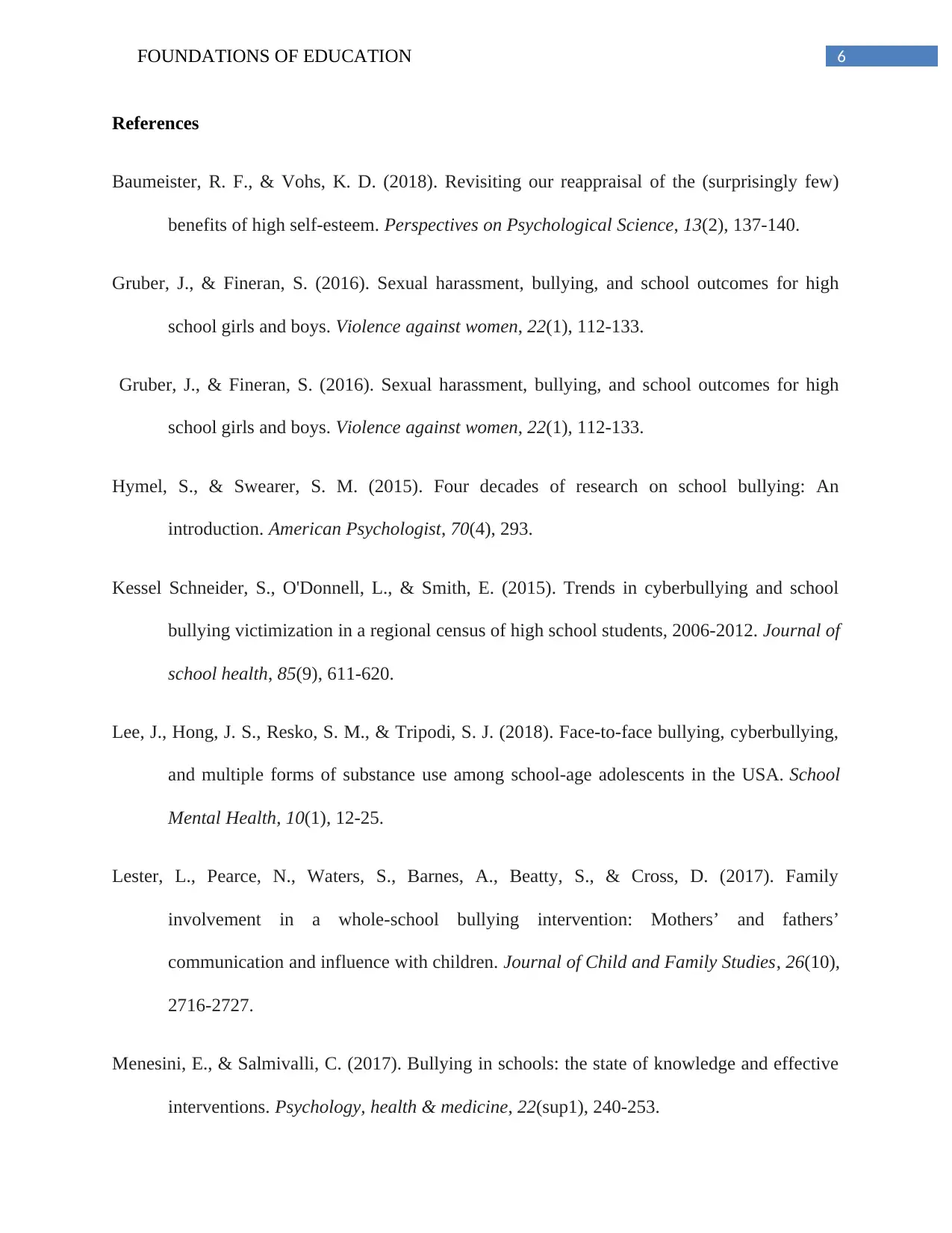
6FOUNDATIONS OF EDUCATION
References
Baumeister, R. F., & Vohs, K. D. (2018). Revisiting our reappraisal of the (surprisingly few)
benefits of high self-esteem. Perspectives on Psychological Science, 13(2), 137-140.
Gruber, J., & Fineran, S. (2016). Sexual harassment, bullying, and school outcomes for high
school girls and boys. Violence against women, 22(1), 112-133.
Gruber, J., & Fineran, S. (2016). Sexual harassment, bullying, and school outcomes for high
school girls and boys. Violence against women, 22(1), 112-133.
Hymel, S., & Swearer, S. M. (2015). Four decades of research on school bullying: An
introduction. American Psychologist, 70(4), 293.
Kessel Schneider, S., O'Donnell, L., & Smith, E. (2015). Trends in cyberbullying and school
bullying victimization in a regional census of high school students, 2006‐2012. Journal of
school health, 85(9), 611-620.
Lee, J., Hong, J. S., Resko, S. M., & Tripodi, S. J. (2018). Face-to-face bullying, cyberbullying,
and multiple forms of substance use among school-age adolescents in the USA. School
Mental Health, 10(1), 12-25.
Lester, L., Pearce, N., Waters, S., Barnes, A., Beatty, S., & Cross, D. (2017). Family
involvement in a whole-school bullying intervention: Mothers’ and fathers’
communication and influence with children. Journal of Child and Family Studies, 26(10),
2716-2727.
Menesini, E., & Salmivalli, C. (2017). Bullying in schools: the state of knowledge and effective
interventions. Psychology, health & medicine, 22(sup1), 240-253.
References
Baumeister, R. F., & Vohs, K. D. (2018). Revisiting our reappraisal of the (surprisingly few)
benefits of high self-esteem. Perspectives on Psychological Science, 13(2), 137-140.
Gruber, J., & Fineran, S. (2016). Sexual harassment, bullying, and school outcomes for high
school girls and boys. Violence against women, 22(1), 112-133.
Gruber, J., & Fineran, S. (2016). Sexual harassment, bullying, and school outcomes for high
school girls and boys. Violence against women, 22(1), 112-133.
Hymel, S., & Swearer, S. M. (2015). Four decades of research on school bullying: An
introduction. American Psychologist, 70(4), 293.
Kessel Schneider, S., O'Donnell, L., & Smith, E. (2015). Trends in cyberbullying and school
bullying victimization in a regional census of high school students, 2006‐2012. Journal of
school health, 85(9), 611-620.
Lee, J., Hong, J. S., Resko, S. M., & Tripodi, S. J. (2018). Face-to-face bullying, cyberbullying,
and multiple forms of substance use among school-age adolescents in the USA. School
Mental Health, 10(1), 12-25.
Lester, L., Pearce, N., Waters, S., Barnes, A., Beatty, S., & Cross, D. (2017). Family
involvement in a whole-school bullying intervention: Mothers’ and fathers’
communication and influence with children. Journal of Child and Family Studies, 26(10),
2716-2727.
Menesini, E., & Salmivalli, C. (2017). Bullying in schools: the state of knowledge and effective
interventions. Psychology, health & medicine, 22(sup1), 240-253.
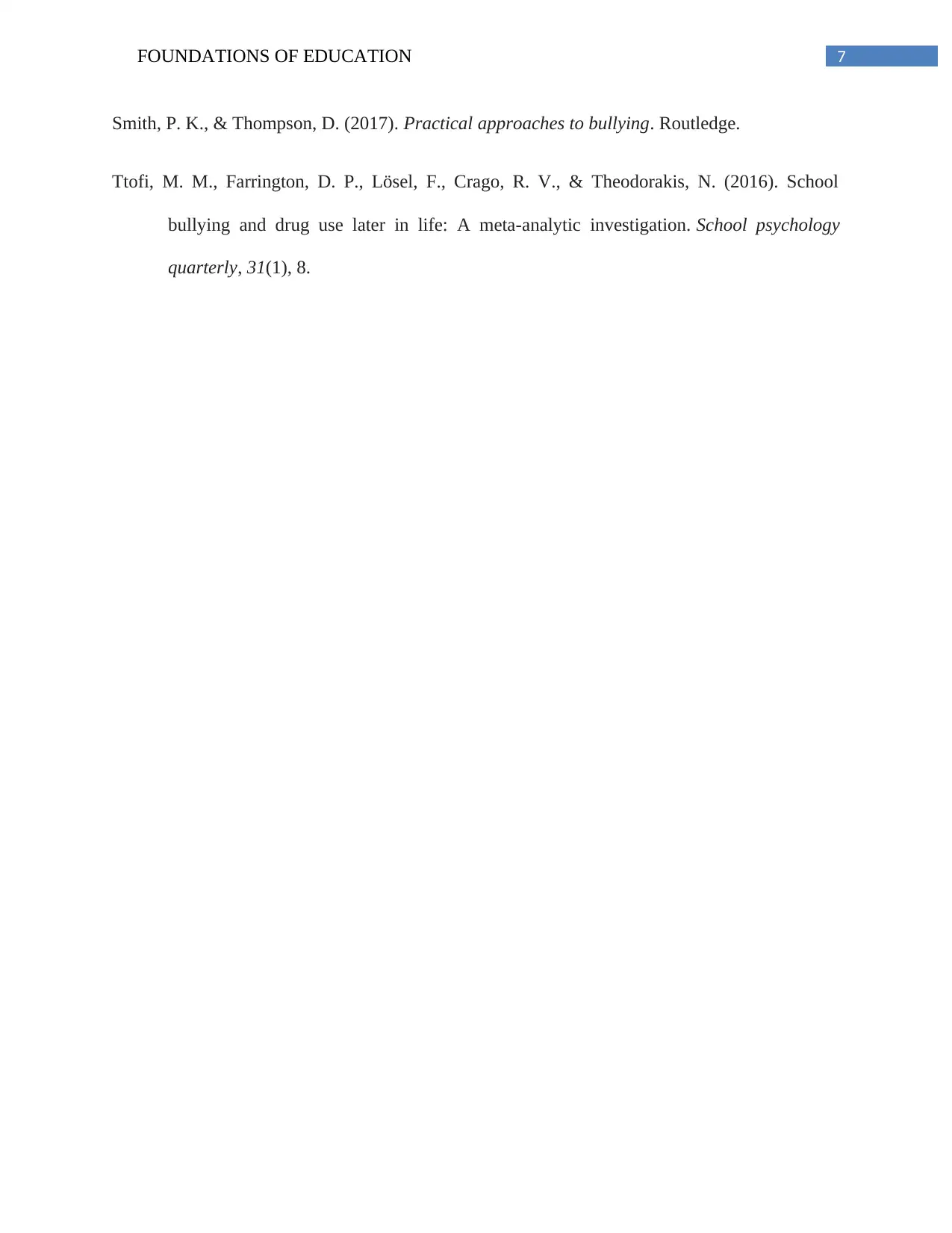
7FOUNDATIONS OF EDUCATION
Smith, P. K., & Thompson, D. (2017). Practical approaches to bullying. Routledge.
Ttofi, M. M., Farrington, D. P., Lösel, F., Crago, R. V., & Theodorakis, N. (2016). School
bullying and drug use later in life: A meta-analytic investigation. School psychology
quarterly, 31(1), 8.
Smith, P. K., & Thompson, D. (2017). Practical approaches to bullying. Routledge.
Ttofi, M. M., Farrington, D. P., Lösel, F., Crago, R. V., & Theodorakis, N. (2016). School
bullying and drug use later in life: A meta-analytic investigation. School psychology
quarterly, 31(1), 8.
1 out of 7
Related Documents
Your All-in-One AI-Powered Toolkit for Academic Success.
+13062052269
info@desklib.com
Available 24*7 on WhatsApp / Email
![[object Object]](/_next/static/media/star-bottom.7253800d.svg)
Unlock your academic potential
© 2024 | Zucol Services PVT LTD | All rights reserved.





